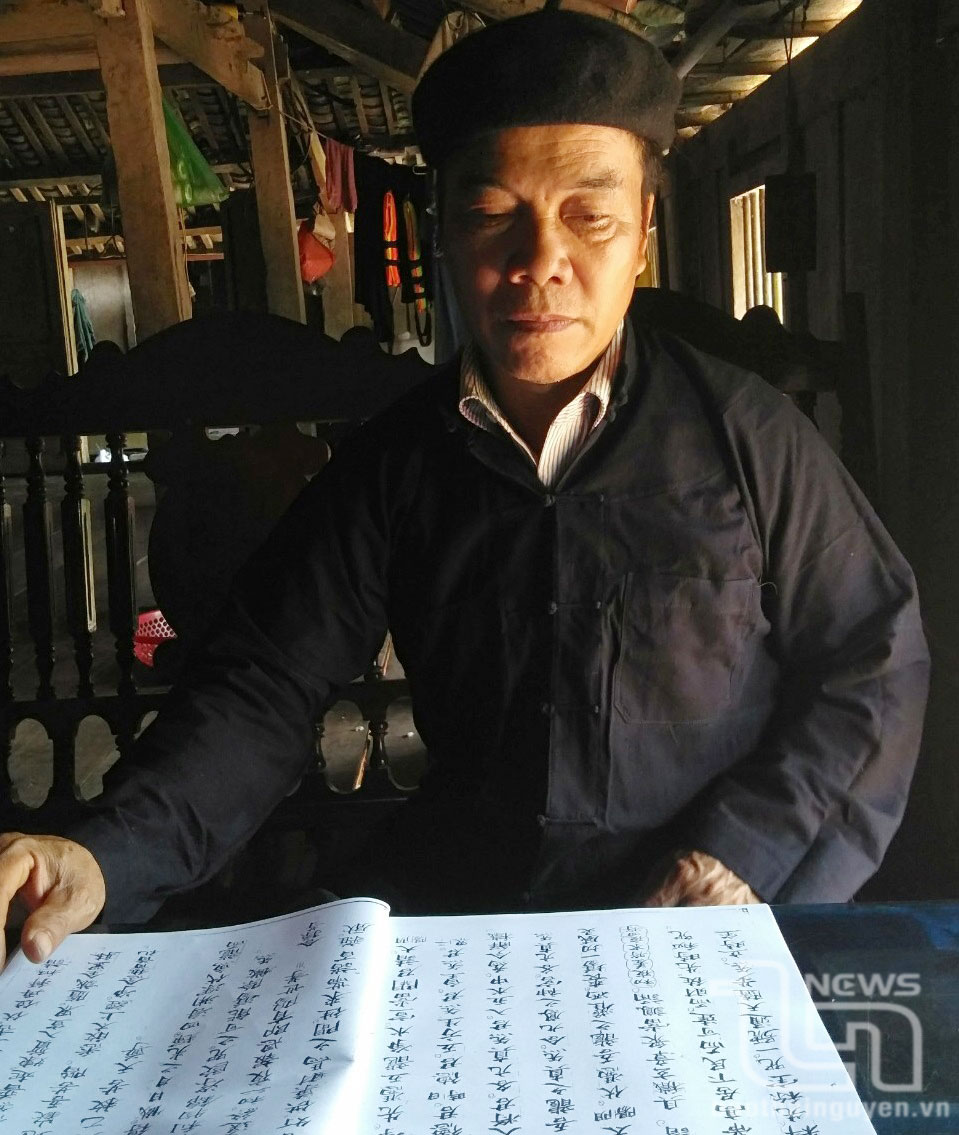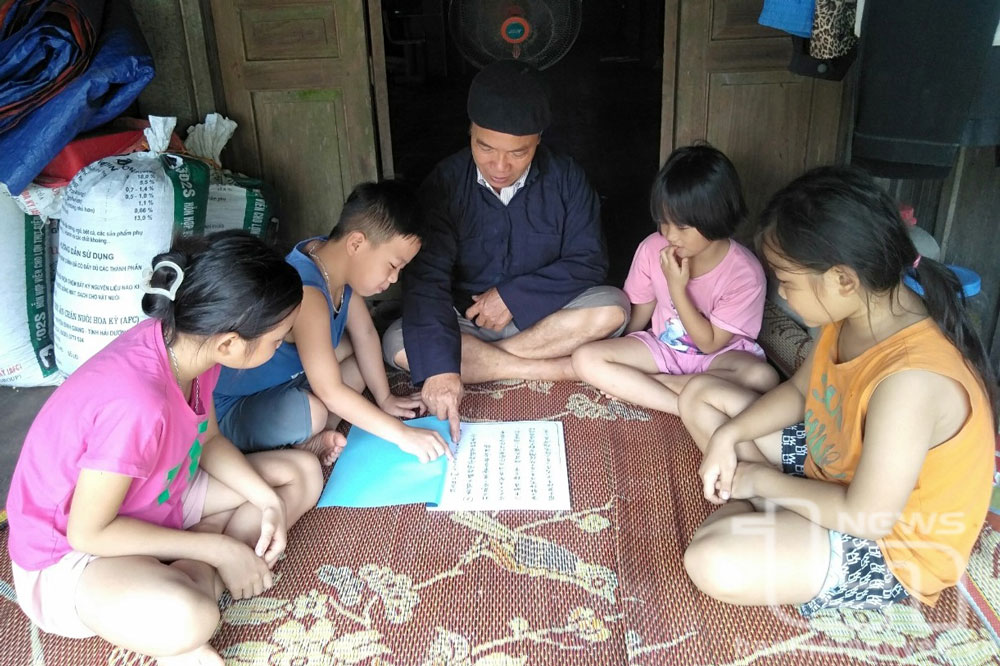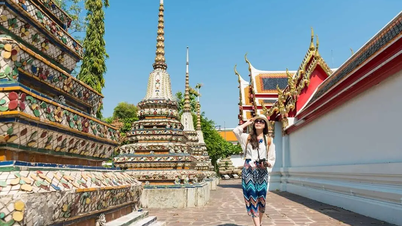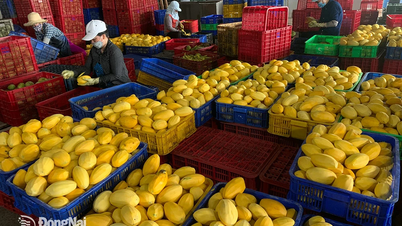Cap sac - an important ritual in the spiritual life of the Nung ethnic group. A person who is granted a cap sac is recognized by everyone in the community as an adult and is allowed to participate in practicing religious rituals in the Nung ethnic community.
 |
| Mr. Chu Van Cam read many books written in ancient Chinese characters with content related to the work of a shaman. |
To learn more about the Cap sac ritual of the Nung ethnic group, we went to Dong Luong hamlet (Tan Long commune, Dong Hy) to meet Mr. Chu Van Cam, a prestigious person in the area, and also a shaman who has directly participated in practicing this ritual for many years.
Mr. Cam said: Since 1930, a number of Nung ethnic families belonging to the Lam, Chu, Ly clans... from Binh Gia ( Lang Son ) migrated to Dong Hy to clear forests, chase away animals, establish villages, and live together with other ethnic groups. Despite many changes and difficulties, the unique cultural beauty of the Nung ethnic group's Cap Sac ceremony has been preserved and passed down through generations like a treasure.
Through the story, we also learned that Mr. Cam's family has been shamans for many generations, a profession that brings spiritual blessings to people. At the age of 20, he followed his father to perform rituals and took on the role of assistant shaman. The elders said that he had a predestined relationship with being a shaman, so they taught him the necessary rituals.
He himself was also aware of the responsibility placed on his family, so he persevered in studying books, diligently studying lessons on "talking to heaven, earth, and people in the underworld". Therefore, he was soon given a ordination ceremony by the superiors, becoming a shaman, a sorcerer with the ability to "perform magic" to comfort the spirits of the people in the Nung ethnic community. He shared: It took many times of performing the ordination ceremony to be recognized by the immortals, allowing him to perform magic to help people.
The ordination ceremony is a major event in a man’s life, but not every man can be ordained. According to the concept of the Nung ethnic group, only those with “roots” can be ordained. Moreover, they must have morality, social knowledge and be respected by everyone in the community…
 |
| Mr. Chu Van Cam teaches his grandchildren ancient Chinese characters. |
Because of the concept that being a ordination holder means honoring one’s family and oneself, the person being granted a ordination holder and his family and clan must prepare carefully every month. Starting with choosing a good day and month, and preparing offerings such as goat, pig, chicken, rice, wine, white cloth, red cloth, colored paper, etc. Each item has its own regulations regarding quantity, not too little or too much.
The main priests performing the ceremony include: Taoist priest, Buddhist priest, shaman and assistant priests. The beginning of the ceremony is to report to the ancestors of the family, to the saints, and to the heavenly officials about a major event of the family. The Buddhist priest opens the way to heaven to welcome the ancestors and ancestors of the family to attend the ceremony, to pray to dispel conflicts and bad luck for the family through small ceremonies: reporting to the ancestors, reporting to the Jade Emperor, offering gifts, and offering incense.
Next are the ceremonies such as: the birth ceremony of the person receiving the ordination, the ceremony of giving tools to the disciple, the ceremony of reading the royal decree, the ceremony of removing bad luck, the ceremony of rewarding the army, the ceremony of seeing off the saint, the ceremony of thanking the ancestors and the gods for supporting and allowing the monks to perform the ordination ceremony and giving gifts to the person receiving the ordination.
The Cap Sac ceremony has great value in the spiritual life of the Nung ethnic group. Because the ceremony has the meaningof educating morality and personality, reminding each person to maintain a respectful and orderly lifestyle in the community and to be grateful to ancestors and gods for their protection.
From an artistic perspective, the Cap Sac ceremony is essentially a folk performance, because the "scenes" are a collection of many forms of performing arts such as plays, singing, music, spirit possession, etc. All are smoothly linked together and performed in a solemn atmosphere, both attractive and mysterious, and close to human life.
With that meaning, the Cap sac ritual of the Nung ethnic group in Thai Nguyen has been decided by the Ministry of Culture, Sports and Tourism to be included in the List of national intangible cultural heritage.
Source: https://baothainguyen.vn/van-hoa/202408/doc-dao-le-cap-sac-cua-dong-bao-dan-toc-nung-153043a/




![[Photo] Vietnamese and Hungarian leaders attend the opening of the exhibition by photographer Bozoky Dezso](https://vphoto.vietnam.vn/thumb/1200x675/vietnam/resource/IMAGE/2025/5/28/b478be84f13042aebc74e077c4756e4b)
![[Photo] Prime Minister Pham Minh Chinh receives a bipartisan delegation of US House of Representatives](https://vphoto.vietnam.vn/thumb/1200x675/vietnam/resource/IMAGE/2025/5/28/468e61546b664d3f98dc75f6a3c2c880)
![[Photo] General Secretary To Lam works with the Central Policy and Strategy Committee](https://vphoto.vietnam.vn/thumb/1200x675/vietnam/resource/IMAGE/2025/5/28/7b31a656d8a148d4b7e7ca66463a6894)
![[Photo] 12th grade students say goodbye at the closing ceremony, preparing to embark on a new journey](https://vphoto.vietnam.vn/thumb/1200x675/vietnam/resource/IMAGE/2025/5/28/42ac3d300d214e7b8db4a03feeed3f6a)

























































































Comment (0)